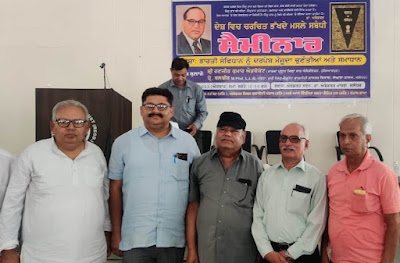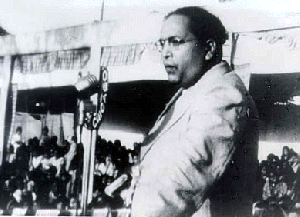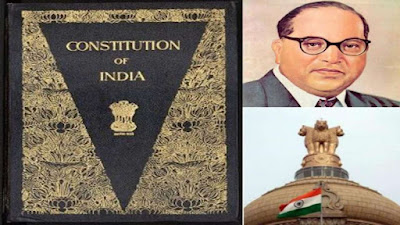(Asian Independent)
-Ramesh chander
Mischievous Suggestions to Change the Constitution of India – Constitution of India is a living document and as such remains in the news on one count on the other. India is passing through challenging times in its ‘tryst with destiny’ under various cross currents. There had been fears and concerns floating around about change of the constitution by vested interests in the ruling outfits and right-wing Hindutava elements; particularly ever since the BJP government came into power in 2014. Right or wrong, BJP and RSS leadership had been rejecting these apprehensions. Nevertheless, the ‘confidence deficit’ persisted and remained which adversely affected the credentials of the government and its professed agenda of “Sab Ka Sath – Sab Ka Vikas – Sab Ka Vishwas”. Of late, the issue has again been revived by the ‘seemingly, ‘motivated’ views of non else but a very highly placed Aide of PM Narenda Modi, Bibek Debroy, Chairman of the Economic Advisory Committee of PM who in an article to coincide with the Azadi Ka Amrit Mahotsav – Independence Day of India wrote, “Much of what we debate begins and ends with the Constitution. A few amendments won’t do. We should go back to the drawing board and start from first principles, asking what these words in the Preamble mean now: socialist, secular, democratic, justice, liberty and equality. We the People have to give ourselves a new Constitution.” Bibek Debroy said this in the background of his thinking, “Azadi Ka Amrit Mahotsav means we have in mind a template for India in 2047. The bedrock of all policies is set by the Constitution, which was adopted on November 26, 1949 by the Constituent Assembly and came into force on January 26, 1950. However, no Constitution should be cast in stone. It is meant to be dynamic and is supposed to reflect the will of the people through Parliament, a point which was repeatedly made during the Constituent Assembly debates. India’s Constitution today isn’t what we inherited in 1950 and rightly so.” Recently speaking in the Rajya Sabha, Former CJI Ranjan Gogoi also expressed his doubts on the so called ‘basic structure of the constitution’. People think that these utterings are deliberately and purposely made to ‘test the waters’ by the ‘Hindutava’ forces who intend to change or even abrogate the constitution. Let us wait and see. But

there are many questions which need to be answered in this regard – Though it was clarified that these were the personal views of Bibek Debroy yet it would need to be clearly stated by the Government of India, BJP, RSS and the main stream of the civil society as to what was there thinking on the subject? It is an important issue. Keeping the issue hanging in the air would amount to playing with fire and ushering India that is Bharat into “Grammar of Anarchy” as warned by Babasaheb Ambedkar himself. The concerned masses particularly belonging to the socially oppressed and depressed segments of the society, minorities and secular forces in the diversified and multi-racial and multi-cultural society are already worried and ready to challenge such uncalled for ‘misadventure’ to change the constitution of India. India is India only because of the constitution. We would ignore this ground reality at our own peril. ‘We the people of India’ must not be oblivious of the nefarious designs of the vested interests to ward off the country of the dangers ahead.
Chupa Kar Asteen Mein Bijliyan Rakhi Hain Gardoon Ne
Anadil Bagh Ke Ghafil Na Baithen Ashiyon Mein
(The sky has kept thunderbolts concealed up its sleeve
Garden’s nightingales should not slumber in their nests)
*****
 Ambedkar Power – Growing Relevance – It may seem somewhat strange and even bizarre to coin a word like ‘Ambedkar Affect’. It may also be called a farfetched preposition – Ambedkar Power is getting increasingly visible in the polity and socio-economic structures of the country and with this relevance of dalits or the weaker sections is getting new meanings. I don’t know whether I would succeed in making my point but nevertheless, I would try and say it anyway. One may recall in 1946 when the first interim government was formed, Congress Party and Muslim League were given equal number of Ministerial berths in the Council of Ministers. Dalit identity by then was already established. Congress Party nominated Jagjivan Ram to give representation to dalits (Ambedkar was not in the reckoning as he was a staunch opponent and critic of Congress Party) and to match the Congress Party, Muslim League nominated Joginder Nath Mandal to accommodate dalit interests. This drama of owning or appropriating dalits started well before the independence. And it continues till today in one way or the other both by the Congress Party and the newly emerged the other biggest party, BJP. Ambedkar and his legacy, to my mind, are solely responsible to bring about this visible scenario with regard to dalits or Scheduled Castes to come in the national reckoning. It seems that it, the Ambedkar Affect, would remain so in the years to come. Congress Party appropriated Babasaheb Ambedkar by nominating him to the Constituent Assembly, making him the Chairman of the Drafting Committee to write the Constitution, appointing him the first Law Minister of India (Pakistan did the same to Joginder Nath Mandal but later things changed and it is a separate issue). Congress Party promoted Jagjivan Ram and the likes of D. Sanjivayya to counter Babasaheb Ambedkar and later the likes of Buta Singh, Chand Ram, Yogendra Makwana etc. came to the centre stage and roped in B.D. Khobragade, B.P. Maurya, Ram Dhan among others to give representation to SCs in the power structures of the country. BJP in the run up to become a pan-India political force n the 1970s, started looking for SC faces to attract the SC vote banks and brought to their fold educated SCs like Ram Nath Kovind, Suraj Bhan, Sonkar Shastri, Sanjay Paswan among others. Congress Party made K.R. Narayanan first Vice President and then President of India to please the SC communities as a well thought-over strategy. ‘Ambedkar Affect’ was at work in shaping the political landscape for the SCs in the scheme of things of both Congress Party and BJP. BJP made Ram Nath Kovind the President of India, recognized Ambedkar by making memorials and celebrating Ambedkar’s 125th birth anniversary, appointed a couple of Governors, made Droupadi Murmu, the President of India. BJP is fully aware of the Ambedkar Affect in the electoral aspects to remain in the corridors of power not only in Delhi but also in the state capitals. In turn, Congress Party picked up Mallikarjun Kharge as the President of Congress Party. Though Kharge Sahib is a leader by his own right yet Ambedkar Affect also played its role in his alleviation to the coveted position.
Ambedkar Power – Growing Relevance – It may seem somewhat strange and even bizarre to coin a word like ‘Ambedkar Affect’. It may also be called a farfetched preposition – Ambedkar Power is getting increasingly visible in the polity and socio-economic structures of the country and with this relevance of dalits or the weaker sections is getting new meanings. I don’t know whether I would succeed in making my point but nevertheless, I would try and say it anyway. One may recall in 1946 when the first interim government was formed, Congress Party and Muslim League were given equal number of Ministerial berths in the Council of Ministers. Dalit identity by then was already established. Congress Party nominated Jagjivan Ram to give representation to dalits (Ambedkar was not in the reckoning as he was a staunch opponent and critic of Congress Party) and to match the Congress Party, Muslim League nominated Joginder Nath Mandal to accommodate dalit interests. This drama of owning or appropriating dalits started well before the independence. And it continues till today in one way or the other both by the Congress Party and the newly emerged the other biggest party, BJP. Ambedkar and his legacy, to my mind, are solely responsible to bring about this visible scenario with regard to dalits or Scheduled Castes to come in the national reckoning. It seems that it, the Ambedkar Affect, would remain so in the years to come. Congress Party appropriated Babasaheb Ambedkar by nominating him to the Constituent Assembly, making him the Chairman of the Drafting Committee to write the Constitution, appointing him the first Law Minister of India (Pakistan did the same to Joginder Nath Mandal but later things changed and it is a separate issue). Congress Party promoted Jagjivan Ram and the likes of D. Sanjivayya to counter Babasaheb Ambedkar and later the likes of Buta Singh, Chand Ram, Yogendra Makwana etc. came to the centre stage and roped in B.D. Khobragade, B.P. Maurya, Ram Dhan among others to give representation to SCs in the power structures of the country. BJP in the run up to become a pan-India political force n the 1970s, started looking for SC faces to attract the SC vote banks and brought to their fold educated SCs like Ram Nath Kovind, Suraj Bhan, Sonkar Shastri, Sanjay Paswan among others. Congress Party made K.R. Narayanan first Vice President and then President of India to please the SC communities as a well thought-over strategy. ‘Ambedkar Affect’ was at work in shaping the political landscape for the SCs in the scheme of things of both Congress Party and BJP. BJP made Ram Nath Kovind the President of India, recognized Ambedkar by making memorials and celebrating Ambedkar’s 125th birth anniversary, appointed a couple of Governors, made Droupadi Murmu, the President of India. BJP is fully aware of the Ambedkar Affect in the electoral aspects to remain in the corridors of power not only in Delhi but also in the state capitals. In turn, Congress Party picked up Mallikarjun Kharge as the President of Congress Party. Though Kharge Sahib is a leader by his own right yet Ambedkar Affect also played its role in his alleviation to the coveted position.

To cut the story short, I come straight to the new political phenomena coming into play in tactical and strategic political moves of BJP to counter Ambedkar Affect and to amend the Constitution of India, linked with the persona of Ambedkar and his legacy, to promote their subtle agenda of Hindutava by firing the salvos from the shoulders of SC leaders in the BJP – appointed Arjun Meghwal as the Law Minister to oversee and pilot the controversial legislative framework at this crucial and challenging times and more recently appointed Former President of India, Ram Nath Kovind as Chairman of the Committee to study and make a report on the issue of ‘One Nation – One Election’. I don’t know exactly whether in the past any government made a Former Mahamahim to Chair a government committee to carry forward its political agenda. Anyway it is a separate matter. The crux of the matter is ‘Ambedkar Affect’ – Ambedkar Ka Zaddu Sar Chad kar Bol Raha Hai. Ambedkar Power is a potent power and will remain so in the days to come. Allma Iqbal’s poetic assertion fully explains the scattered fragrance of Ambedkar Power in the socio-political and even socio-cultural life of the country:-
Uthaye Kuch Waraq Lale Ne, Kuch Nargis Ne, Kuch Gul Ne
Chaman Mein Har Taraf Bikhri Huwi Hai Dastan Meri
(Some leaves were picked up by the tulip, some by the narcissus, some by the rose
My story is scattered around everywhere in the garden)
Urha Li Qumriyon Ne, Tootiyon Ne, Andleebon Ne
Chaman Walon Ne Mil Kar Loot Li Tarz-e-Faghan Meri
(The turtle‐doves, parrots, and nightingales pilfered away
The garden’s denizens jointly robbed away my plaintive way)








